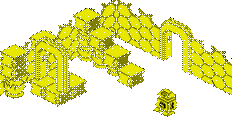






 |
 Connectors Connectors
- Cartridge slot - top-loading on original Famicom, front-loading on NES (72-pin on NES, 60-pin on original Famicom and NES-101)
- RF out for TV connection (all models)
- RCA component out for TV connection or composite monitor (original NES only)
- Two game controller connectors on NES (proprietary 9-pin) - Famicom had the controllers hard-wired into the back of the unit.
- Expansion slot (15-pin D-sub on Famicom's front panel or on underside on NES)
- Microphone (on Famicom's second controller only)
 Technical Facts Technical Facts
- The Japanese NES-101 Famicom system is not region locked, so you can play all Famicom/NES games on it, whereas the original NES (not the front-loading 101) contained the "10NES" lockout chip, although later revisions of the NES consoles contained different lockout chips for different regions, making games that were only to be sold in that region playable on their locally sold consoles.
- The original Famicom's second controller didn't have the START and SELECT buttons. Instead it featured a built-in microphone, although very few games made use of this feature. On the NES, both controllers were identical with them both having START and SELECT buttons and no microphone.
- A blinking red light power light means your console has a problem with its 10NES lockout chip - a common problem. The reason for the blinking power light is that the console is actually being reset every second by the lockout chip! The cause of this problem is usually dirty or bent connectors in the game cart (the lockout chip demands constant communication with the game cart chip). Another symptom was a solid white, gray or green screen on startup.
- The CPU used on the NES is a customised version of the MOS 6502, with built-in sound hardware and a restricted DMA controller on-die. To save some space on the silicon, the Ricoh-produced chip omitted the 6502's BCD (Binary-coded Decimal) mode.
- The PPU (Picture Processing Unit) used in the Famicom/NES - the Ricoh RP2C02 (NTSC) or RP2C07 (PAL) - was advanced for its time. It featured not only very efficient memory usage, but also provided full sprite support, moving backgrounds, and many simultaneous colours. Nintendo actually later extended its functionality to help the NES compete alongside the graphically superior Sega Master System through the use of 'mappers' placed on the game carts. These memory modules could bank-switch to the memory address space of the PPU, thus allowing the NES to create more advanced graphics, using more colours and bigger tile sets.
- The various known lockout chips are: USA/Canada (3193 lockout chip), most of Europe (3195), Asia (3196) and UK/Italy/Australia (3197).
 Trivia Trivia
- The very earliest Famicom units had square A and B buttons on its controllers.
- Later clones of the NES made use of advances in technology with the NOAC (NES-on-a-chip)
- The North American (NES) "Game Pak" was much larger than the Japanese Famicom's, measuring 5.25" tall x 4.75" wide and 0.75" thick. Japanese carts measured 2.75" tall x 4.25" wide.
- Standard Game Pak games featured a grey label if they didn't support batterybackup or gold (and sometimes silver) is they did!
- With the exception of two games (Legend of Zelda and Zelda II: The Adventure of Link), all licensed NTSC and PAL NES Game Paks were grey plastic in colour. Unlicensed ones were black, blue and gold. This was not the case for the Japanese market, where many different colours were used for the casings.
- Sharp Corporation licensed the Nintendo Famicom to build it into its 19SC111 television!
- The original square A and B buttons on the Famicom were soon changed to circular ones because as the buttons were pushed down, they often got caught on the controller's casing and wouldn't pop-up again.
- Games produced to be locked to the UK/Italy/Australia market typically had an 'A' on the game box with text that read: "This game is only compatible with the Mattel or NES versions of the Nintendo Entertainment System". Rest-of-Europe games typically had a 'B' on the box along with text that read "This game is not compatible with the Mattel or NES versions of the Nintendo Entertainment System".
|
| |
|
|
 Connectors
Connectors  Technical Facts
Technical Facts Trivia
Trivia








